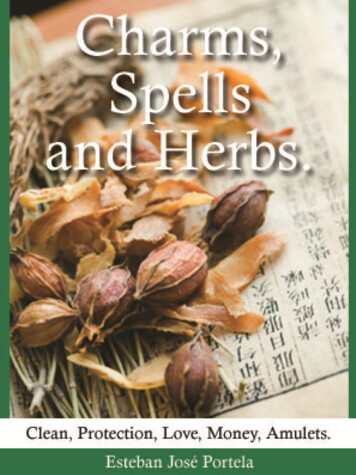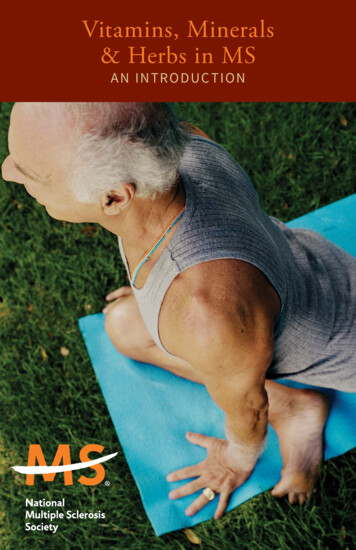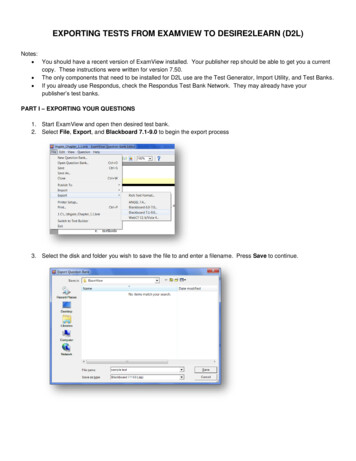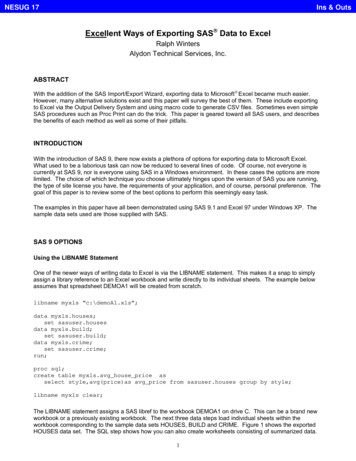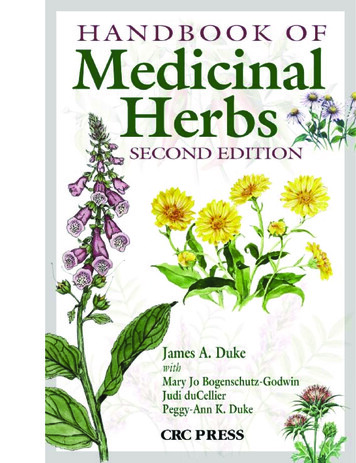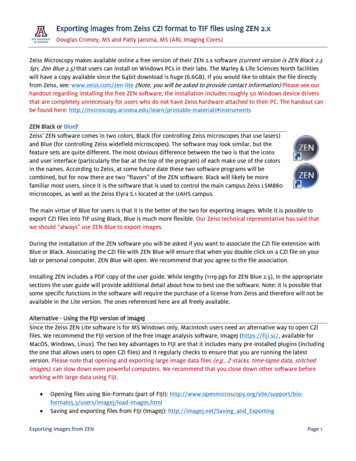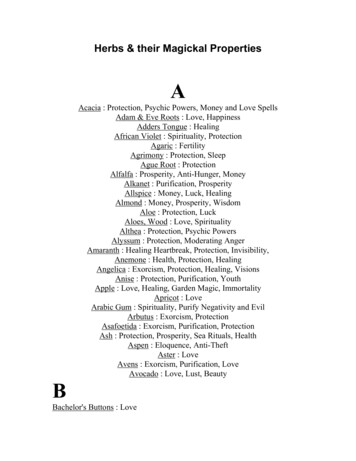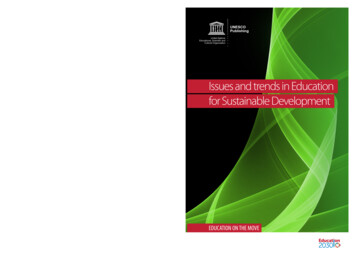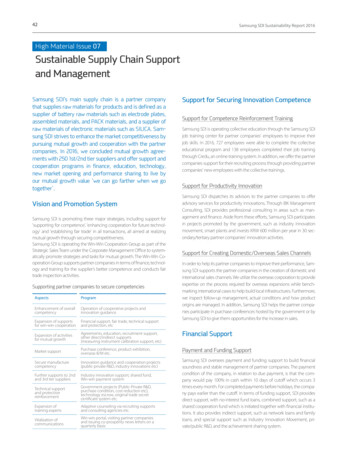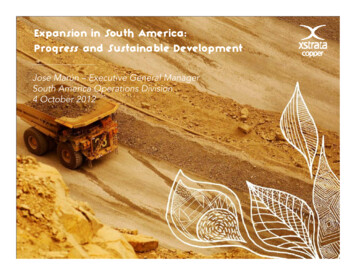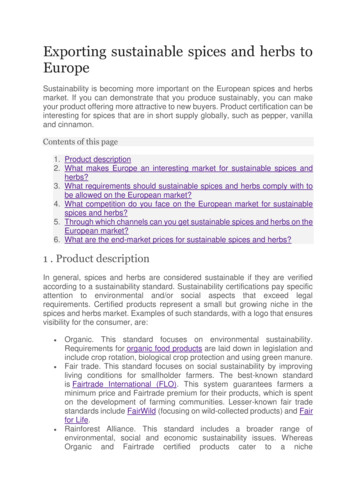
Transcription
Exporting sustainable spices and herbs toEuropeSustainability is becoming more important on the European spices and herbsmarket. If you can demonstrate that you produce sustainably, you can makeyour product offering more attractive to new buyers. Product certification can beinteresting for spices that are in short supply globally, such as pepper, vanillaand cinnamon.Contents of this page1. Product description2. What makes Europe an interesting market for sustainable spices andherbs?3. What requirements should sustainable spices and herbs comply with tobe allowed on the European market?4. What competition do you face on the European market for sustainablespices and herbs?5. Through which channels can you get sustainable spices and herbs on theEuropean market?6. What are the end-market prices for sustainable spices and herbs?1 . Product descriptionIn general, spices and herbs are considered sustainable if they are verifiedaccording to a sustainability standard. Sustainability certifications pay specificattention to environmental and/or social aspects that exceed legalrequirements. Certified products represent a small but growing niche in thespices and herbs market. Examples of such standards, with a logo that ensuresvisibility for the consumer, are: Organic. This standard focuses on environmental sustainability.Requirements for organic food products are laid down in legislation andinclude crop rotation, biological crop protection and using green manure.Fair trade. This standard focuses on social sustainability by improvingliving conditions for smallholder farmers. The best-known standardis Fairtrade International (FLO). This system guarantees farmers aminimum price and Fairtrade premium for their products, which is spenton the development of farming communities. Lesser-known fair tradestandards include FairWild (focusing on wild-collected products) and Fairfor Life.Rainforest Alliance. This standard includes a broader range ofenvironmental, social and economic sustainability issues. WhereasOrganic and Fairtrade certified products cater to a niche
market, Rainforest Alliance certified spices and herbs target mainstreamtraders, processors, brands and consumers.However, not all buyers require spices and herbs to be certified according to asustainability certification. Buyers also define sustainability standardsthemselves and do not necessarily communicate these to the consumer; oneexample is Unilever’s Sustainable Agriculture Code.Usually, if you follow the sustainability standards of your buyer, you do not needto certify your spices and herbs. Buyers may either ask that you comply withsupplier codes of conduct or assess your performance in sustainability issues.European buyers have different approaches to sustainability, based on variousdefinitions, priorities and levels of ambition. Many European players will look atthe sustainability performance of their suppliers throughout the entire supplychain.2 . What makes Europe an interesting market forsustainable spices and herbs?Growing demand for specific sustainably produced spices and herbs due tosupply scarcitySustainability is becoming increasingly important in the spices and herbs sector.Demand for sustainable spices and herbs is growing, although it depends onthe specific product wow rapid this growth is. The demand for sustainableproducts is highest for spices and herbs with a large international market andsupply scarcity. According to European buyers, these include: PepperCinnamonChilli and paprikaVanillaOne of the main reasons for the growth in demand for sustainable spices andherbs is the increasing supply scarcity for many spices and herbs. If productsare scarce, ensuring their future availability becomes key. Sustainableproduction and harvesting also become more and more important, as in thecase of cinnamon and pepper. In addition, spice importers and manufacturersare following the general trend of sustainability in the food sector.Key sustainability issues in the spices and herbs sector include: The use of pesticidesChild labourHealthy and safe working conditionsFair payment for farmers
Tips: If you are a new producer, demonstrate to your potential buyer that youcan offer a continuous supply of good-quality sustainable spices andherbs which comply with food safety requirements.Invest in establishing long-term trade relationships with your buyers.Educate your suppliers in improving efficiency and agronomics toimprove your supply continuity.Stay up to date on market developments and keep an eye on your largestcompetitors. This information can indicate which spices and herbs are inshort supply and where sustainability will become more important infuture. Consult multiple sources, as estimates and projections are onlyvalid for 4-6 months and can be incorrect. Moreover, productionprognoses and market conditions can change rapidly.Look for online crop reports to anticipate supply scarcities; for example,from the European Spice Association, McCormick and Nedspice, orpublic sources such as Business Standard. You can also visit eventswhere these reports are shared by sector experts, such as conferencesor trade fairs, or ask your buyers for this information.More and more sustainability initiatives in the spices and herbs industryIncreasingly, companies are looking for ways to operate sustainably withoutcertifying according to the main sustainability standards; for example, throughlow-cost certification or a supplier assessment against a buyer’s supplier code.Many sustainability projects focus on: Increasing yields; for example, through improved water management,better use of fertilisers or implementing crop protection measuresEnsuring a stable income for farmersReducing the use of as McCormick, Olam and Unilever are implementing sustainable practicesthroughout their entire supply chain, linking their brand and quality directly tosustainability. An example is Olam’s AtSource, which enables manufacturers totrace the source of their supply.European companies also set up projects for specific spices and herbs. Forexample, Nedspice developed a sustainability standard for pepper in Vietnam,while Unilever joined up with Symrise to train vanilla farmers in sustainablepractices.Another industry initiative aimed at vanilla is the Sustainable VanillaInitiative (SVI). The SVI is hosted by the Sustainable Trade Initiative (IDH) incollaboration with US-based Sustainable Food Lab (SFL). The SVI aims to
improve vanilla bean farmers’ livelihoods and assure the long-term stablesupply of high quality natural vanilla. To illustrate, flavouring manufacturerFirmenich (Switzerland) established an agreement with their supplier Uvan(Uganda) to share the mutual benefits of their cooperation.Tip: See our study of trends on the European spices and herbs market foradditional information on sustainability and other trends.Demand for certified spices and herbs fails to keep up with suppliesEurope is one of the largest global markets for certified sustainable products,with most demand coming from northern and western European countries.However, certified spices and herbs only make up a small share of the totalmarket for spices and herbs. Industry experts indicate that supply for thesecertified spices and herbs exceeds demand from the market, which makes thefuture of certification in this sector unclear.The development of the certified spices and herbs market is lagging behind incomparison to, for example, the market for certified coffee, cocoa and tea. Thereasons for this are the following: Traded volumes are lower for spices and herbs.The sector is highly fragmented and comprises many different products,production regions and companies.Spices and herbs only account for a small share of the total productcomposition, which means that the need for certification is smaller.Whether or not European buyers are interested in buying certified spices andherbs depends on how they communicate this product to their customers.Industry sources indicate that 80-90% of spices and herbs are used as foodingredients instead of final products. When a spice makes up a small share ofa product, it is difficult to communicate its sustainability to consumers. Europeanfood manufacturers are more interested in certified spices and herbs if they arepart of an entirely certified food product.At the same time, a large share of European consumers and buyers often donot want to pay a premium for certified sustainable spices and herbs as an endproduct. As a result, certified sustainable spices and herbs make up a smallniche of the total spices and herbs market. Organic certified spices and herbsoffer an exception, as consumers believe that these products have a higherquality.If you do not certify your products according to sustainability standards, you canstill make your products ready for certification. Certification covers a wide rangeof issues such as traceability and risks. If you can solve some of these issues,
you can add value to your product and company. This strategy could make iteasier to attract new buyers. Moreover, it makes it easier for you to certify yourproducts in future, if your buyer requires you to or if you want to target themarket niche for certified spices and herbs.Tips: Find out what your buyer expects from you in terms of sustainability andalways verify if they are interested in certified ingredients. Europeancompanies have different definitions, priorities and ambition levels whenit comes to sustainability. Some may want you to comply with their codeof conduct or sustainability code, while others expect productcertification.Look for possible partners to promote sustainability. You can useavailable programmes and subsidies from governmental or nongovernmental organisations in developed countries for investments insustainability. For more information, see websites such asthe Sustainable Spice Initiative, the Netherlands Enterprise Agency,the GermanMinistryforEconomicCooperationandDevelopment or Cordaid.Determine if certifying your spices and herbs is feasible. Can you findenough buyers for your product to offset your investments? You can lookfor buyers online, such as on the website of the International TradeCentre. In addition, you can look for exhibitors at BioFach, the mostimportant European organic trade fair.Target western and northern European countries with your exports ofcertified sustainable spices and herbs. Be aware that these countriesvalue different aspects of sustainability. For example, the UnitedKingdom is the largest global market for Fairtrade products. In Germany,buyers are more focused on quality and opt for Organic certified products.Make sustainability part of your core business. Try to provide a fullytraceable product, improve your control over the supply chain, make yourproduction more sustainable, invest in farmers and train them insustainability issues.If you choose not to certify your product, show your buyers how youensure sustainability. Add pictures or stories to your product on theimpact of sustainability or the origin of your product. This strategy canmake your offer more valuable.See our study of buyer requirements for spices and herbs for additionalinformation on certification standards.Rapidly growing organic food marketThe European organic market continues to grow rapidly. In 2018, the marketreached 33 billion, representing an impressive increase of around 12%
compared to the previous year. Many large retailers and speciality shops inEurope include organic, sustainable spices and herbs in their product offerings.European demand for organic food is growing, especially in northern andwestern Europe: Ireland ( 22% in 2016)France ( 22% in 2016)Norway ( 20% in 2016)Denmark ( 20% in 2016)Finland ( 14% in 2016)Italy ( 14% in 2016).The average per capita consumption of organic food products amounted to 40.80 in 2016. Countries that spend most on organic products, per capita, are: Switzerland ( 274)Denmark ( 227)Sweden ( 197)Luxemburg ( 188)Austria ( 177)Liechtenstein ( 171).Note that there are no specific data available about the market for organicspices and herbs, although spices are assumed to follow the trend mentionedabove.Tips: Stay up to date on developments in the European organic market bychecking online sources. Examples include Online-market.info and thereport “Organic in Europe”by the Research Institute of OrganicAgriculture (FiBL) and the International Federation of Organic AgricultureMovements (IFOAM).Target western and northern European countries with your organic spicesand herbs, as these are spending most on organic food products.See our buyer requirements below for more information on Organiccertification.Increased sales of Fairtrade certified spices and herbsFairtrade International includes sales data on Fairtrade certified spices andherbs in their data on herbs, herbal teas and spices
Globally, sales of Fairtrade certified herbs, herbal teas and spices reached 3.4thousand tonnes in 2015. This represented a growth of 44% compared to 2014,with almost 80% of these sales consisting of herbal teas or composite products.Between 2011 and 2012, sales data only covered herbs and spices. From 2013on, Fairtrade International included sales of herbal teas in the same category.Compared to sales of Fairtrade certified herbs and spices, the total sales ofherbal teas are much larger. This could indicate that herbal teas are the mainreason for the 2013-2015 sales growth of the total product group.The growth in sales of Fairtrade spices and herbs amounted to around 14%.Of all Fairtrade spices and herbs sales in 2015, 40% was sold in the UnitedKingdom. Traditionally, this market is by far the largest market for all Fairtradeproducts. The United Kingdom accounted for almost 30% of the global sales ofall Fairtrade certified products in 2015. The United States accounted for 34% of2015 sales of herbs, spices and herbal teas, while the rest of the worldaccounted for an additional 26%. Other top-selling countries in Europe include: GermanyFranceThe NetherlandsSwitzerlandSales of dual certified products (both Fairtrade and Organic certified) decreasedin the last year. These products accounted for 35% of the total 2015 sales, withhalf of these products sold in the United States. In Europe, large supermarketssell Fairtrade sustainable spices and herbs combined with Organic certification,such as Bart’s Organic and Fairtrade pepper mills.Tip: Target the United Kingdom and buyers in other western Europeancountries with Fairtrade certified spices and herbs, as these are thelargest European markets for Fairtrade products.Pepper accounts for highest sales of Fairtrade certified spices and herbsSales of Fairtrade vanilla grew the most rapidly between 2012 and 2014 by 34%annually.Between 2013 and 2014, Fairtrade sales of black pepper and turmeric grewstrongly as well, by 9% and 16% respectively.Tips:
Always discuss options for Fairtrade certification with your buyers. Seethe section on buyer requirements below for more information on theFairtrade standard.Check the website of Fairtrade International for more information.Consumers and food industry reluctant to pay premium for RainforestAlliance certificationSince 2013, spices and herbs can also be certified with the Rainforest Alliance(RA). The largest drivers of RA certified sustainable spices and herbs aremembersofthe SustainableSpiceInitiative suchas Euroma, Olam and Nedspice. These members have invested in trainingfarmers and exporters in the countries of origin to comply with RA requirements.In 2016, almost 36 thousand tonnes of spices were produced under RAcertification. The main products include: Chillies (64% of 2016 production)Pepper (10%)Vanilla (9%)There is a growing demand among producers for RA certified herbs in recentyears. In 2016, certified products amounted to around 38 thousand tonnes ofherbs. These products also include herbs used in herbal infusions, such asyerba mate, rooibos and mint. The largest products include: Tarragon (64% of 2016 production)Chives (5%)Coriander (4%)The Rainforest Alliance standard is still new to many European consumers. Atthe same time, several European companies state that it is difficult to get apremium on their products for RA certified spices and herbs. Some ask for apremium, but consumers and the food industry are reluctant to pay it.According to industry sources, the European demand for RA certified spicesand herbs is lower than the supplies of these products. As a result, a large shareof RA certified spices and herbs are sold as non-certified products.It might still be interesting for you to get RA certification, as the organisationalso offers training in efficiency.Tip: Check the website of the Sustainable Agriculture Network (SAN), whichdeveloped the Rainforest Alliance standard, for a list of certified farms
and operations. This list also gives an overview of the types andquantities of products that are certified.Insufficient supplies of spices meeting strict European food safetyrequirementsThere are more and more problems with pesticides in spice and herbproduction. A large share of the pepper crop from Vietnam, for example, fails tocomply with European legislation. Products that do comply with Europeanlegislation are even offered at a premium.Moreover, because there are many small suppliers in the supply chain of spicesand herbs, full transparency and traceability to the field does not exist.Traceability is key to ensure food safety and is a requirement underthe European General Food Law Regulation. This regulation defines traceabilityas the ability to trace and follow food and ingredients throughout all stages ofproduction, processing and distribution.In future, traceability will become even more important, both from buyers andfrom consumers who are increasingly interested in knowing where theirproducts come from (see the section on consumer trends below). To ensuretraceability, buyers are more willing to source directly from producers.Tips: Make your supply chain transparent for European buyers. Ensure thatyou provide a fully traceable product. Use appropriate tracking andtracing or other audit and certification systems to show where youringredients come from. This strategy can make it easier for you to accessthe European market by distinguishing yourself from the competition.Also demonstrate that you are a reliable supplier in terms of qualityconsistency, delivery, packaging, service delivery and supply security.See the section on legal and quality requirements below for additionalinformation on food safety requirements.See our tips on doing business for additional information.European consumers increasingly demand sustainable productsThe demand for sustainability is driven by two main societal trends: a growingconsumer awareness of health, and an increased interest in the origins of food.Consumers have become more aware of what they eat, since health andsustainability are interrelated in the mind of the consumer. Organic products areconsidered to be healthier, as they do not use chemicals. For this reason,Organic certification of food products is an important driver for certification inspices and herbs.
In response to the health trend, European companies are increasingly offeringhealthier products to a growing niche of consumers. For example, Unilever inthe Netherlands is changing recipes and formulas to reduce the salt intake oftheir customers, largely by using herbs and spices instead. Schwartz in theUnited Kingdom offers salt-free or low-salt spice and herb mixtures.The growing consumer interest in knowing where food comes from also drivesthe demand for social sustainability, as consumers want to know more aboutthe people who harvest and produce their food. Companies respond to this bylabelling products with QR codes or by storytelling from the farmers, which isalso a driver for certifications such as Fairtrade.Tips: Discuss certification options with your buyers and assess their interest incertified Fairtrade or Organic spices and herbs.If you choose not to certify your products, provide your buyers withstories, pictures or videos to show their social aspects.3 . What requirements should sustainable spices andherbs comply with to be allowed on the Europeanmarket?You can only export sustainable spices and herbs to Europe if you comply withthe buyer requirements for spices and herbs.Legal requirementsIf you fail to comply with European legal requirements, your product can berejected at the border or withdrawn from the market. Compliance is key and caneven result in a price premium for your product. When exporting to Europe, youhave to comply with the following legally binding requirements: Food safety. Traceability, hygiene and control measures are specified inthe General Food Law.Mycotoxins contamination. This is a risk for many spices, as theEuropean Union sets maximum levels for mycotoxins in specific spices.For example, pepper, capsicum, ginger, turmeric or nutmeg have amaximum level of aflatoxin between 5.0 μg/kg (aflatoxin B1) and 10 μg/kg(total aflatoxin content B1, B2, G1 and G2).Maximum residue levels of pesticides. This is one of the main issues forsustainable spices and herbs exports.Microbiological contamination. The presence of Salmonella is the mainreason for banning sustainable spices and herbs from the Europeanmarket.
Food additives and adulteration. Spices and spice blends are rejected bycustoms authorities for containing an undeclared, unauthorised orexcessive presence of extraneous materials.Maximum levels of polycyclic aromatic hydrocarbons (PAHs).Contamination with PAHs is the result of bad drying practices.Irradiation. This practice is allowed but uncommonly used, as consumersdo not always accept this treatment. Discuss this option with your buyer.More and more often, European buyers require suppliers to use steamsterilisation to combat the microbiological contamination of sustainable spicesand herbs. You can earn a significant premium if you are able to supplysustainable spices and herbs that are sterilised at the source. However,investments in the necessary equipment have a high cost of up to 1 million.Steam sterilisation could be damaging to the crop, as it can harm the taste ofthe sustainable spices and herbs. Research is conducted into alternatives tothis method. Currently, it is still the cheapest and safest method to combatmicrobiological contamination.Tips: Check the Rapid Alert System for Food and Feed (RASFF) database forexamples of spices and herbs withdrawn from the market and thereasons behind these withdrawals.Comply with the requirements listed above. Your buyer will transfer costsfor cleaning contaminated sustainable spices and herbs to you if you failto comply.Always discuss with your potential buyers if they want steam sterilisation.If you cannot sterilise your sustainable spices and herbs yourself, look forlocal sterilisation companies that can provide this service for you.Comply with food safety requirements during drying, storage, processing(such as sieving, mixing, grinding or crushing), packaging and transport.If you fail to comply, steam sterilisation does not work.You also need to prevent contamination with mycotoxins and othercontaminants, because steam sterilisation cannot take these out.Keep up to date with the development of steam sterilisation alternativesby checking online sources such as GreenFooDec.Compare your company with your potential buyer to find a strategic fit.Can you comply with extra-legal food safety and sustainabilityrequirements? What quantities of supplies can you deliver? What type ofproduct do you produce, mainstream or niche?Sustainability requirementsThere is no universal definition of sustainability in the spices and herbs sector.Generally, the sustainability of products needs to be verified according to a
standard, but they do not need to be certified. Options to meet sustainabilityrequirement include: Sustainable product certification. The best-known certification standardsare Organic, Fairtrade and Rainforest Alliance. Lesser-known standardsinclude FairWild and Fair for Life.Self-verification. Suppliers assess their own compliance with thesustainability code of buyers. Examples include Unilever’s SustainableAgricultural Code (SAC) or the Olam Livelihood Charter.Corporate Social Responsibility (CSR). Companies have differentrequirements for CSR, which may include signing their code of conductor following common standards such as Supplier Ethical Data Exchange(SEDEX), Ethical Trading Initiative (ETI) or Business Social ComplianceInitiative (BSCI).Tip: Check the Sustainable Spices Initiative Equivalency Tool for moreinformation on different certification standards.Additional requirementsConsider complying with non-legal requirements to ease market access. Bycomplying with these requirements, you can create a competitive advantageover competitors through your company or product offering. European buyerscan use these requirements as selection criteria.Food safety certification can be used as a guarantee of compliance with buyerrequirements. The most important food safety management systems in Europeare British Retail Consortium (BRC), International Featured Standards (IFSFood), Food Safety System Certification 22000 (FSSC22000) and Safe QualityFood Program (SQF).Always verify your buyer’s preference for a specific food safety managementsystem, as some may prefer the one system over the other. For example, BRCis developed by retailers in the United Kingdom and more commonly demandedin this market. If you want to target the United Kingdom, BRC may be moreimportant.Quality requirementsProduct quality is a key issue for buyers in Europe, as you need to comply withthe Quality Minima Document from the European Spice Association (ESA).This document is leading for the national spice associations in Europe and formost key players in the market.
It specifies the legal European requirements for unprocessed spices and herbs,as well as additional buyer requirements that are not laid down in legislation.This document does not cover crushed or ground spices and herbs.In the country of production, spices and herbs are graded according to thenational standard. Moreover, ISO standards give general guidelines on grading,handling and packaging spices and herbs. The American Spice TradeAssociation (ASTA) developed cleanliness specificationsfor spices and herbs.European buyers often use these specifications, as the European SpiceAssociation has not developed similar specifications.Tips: At a minimum, do some rudimentary cleaning. Use detection andprevention methods to ensure that your sustainable spices and herbs arenot contaminated with metal, stone or animal droppings.You can also use more sophisticated cleaning methods to add value toyour product.Check the ISO website for standards on the spice that you produce.Follow the European Spice Association’s Quality Minima Document onthe chemical and physical parameters that your unprocessed sustainablespices and herbs needs to comply with when it is sold in Europe.Labelling requirementsCorrect labelling is important for European buyers, which means that you shouldpay extra attention to labelling your product.For bulk sustainable spices and herbs, your product label must include: the name of the productdetails of the manufacturer (name and address)batch numberdate of manufactureexpiry dateweight of contents.Other information that the exporting and importing country require includes thebarcode, the producer and/or packager code, and any extra information thatcan be used to trace the product back to its origin.Tips: See our study of value-added spices and herbs for requirements onconsumer packaging and labelling. In Europe, there are very strictrequirements for packaging and labelling of consumer products, whichdiffer from the requirements mentioned here.
See the website of the European Commission for additional informationon food labelling legislation. This legislation only applies to final productsthat are sold directly to consumers.Packaging requirementsSpices and herbs (whole and powdered) should be packaged in new, clean,durable and dry: jute bagscloth bags laminated with polyethylene or polypropylenepoly-woven bags with inner linings made of food-grade materialpoly pouches or high-density polyethylene (HDPE) bags made of foodgrade material.Crushed and ground spices and herbs can also be packaged in new, clean,durable, and dry containers made of tin or glass, as well as in polypropylenebags or pouches of food-grade plastic materials to prevent the loss of flavour.Do not use polythene bags, because these result in flavour loss.The packaging must be free from: insect infestationfungus contaminationundesirable or bad odourssubstances that may damage the contents.Tips: Always ask your buyer for their specific packaging requirements.Store packaged spices and herbs in a dry, cool place to prevent qualitydeterioration.Physically separate certified sustainable spices and herbs from anynoncertified or non-sustainable spices and herbs that you produce.Make sure that you can identify all your sustainable products throughoutall stages of the supply chain, such as storage, transport, processing,packaging, labelling and handling. Also include this information in yourdocumentation.See the certification standards Organic, Fairtrade (see the section ontraceability) and Rainforest Alliance (Chain of Custody) for information ontheir specific packaging and labelling requirements.4 . What competition do you face on the European marketfor sustainable spices and herbs?
There are some key differences between the general spices and herbs marketand the sustainable market. It can be more difficult to enter the market
example is Unilever’s Sustainable Agriculture Code. Usually, if you follow the sustainability standards of your buyer, you do not need to certify your spices and herbs. Buyers may either ask that y
